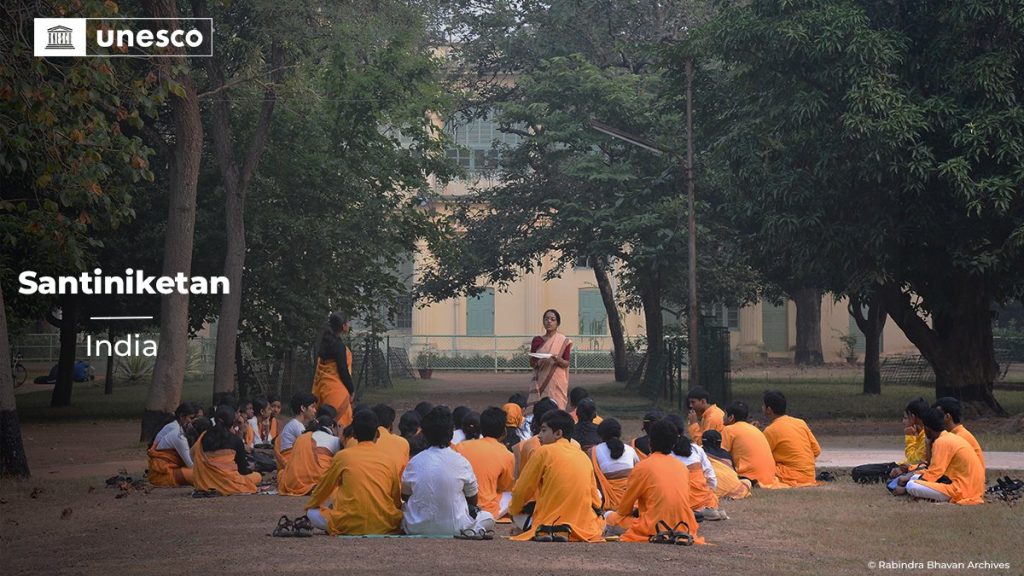Historic Recognition
Santiniketan, the cultural and educational institution founded by Nobel laureate Rabindranath Tagore over a century ago, has achieved a significant milestone by being inscribed on the UNESCO World Heritage List. This recognition, granted during the 45th World Heritage Committee Meeting held in Riyadh, Saudi Arabia, is an example of the enduring legacy of this renowned site located in the Birbhum district of West Bengal, India.
UNESCO’s Announcement
UNESCO made the announcement of Santiniketan’s inclusion in the prestigious World Heritage List via a post on the social media platform X (formerly Twitter). In its tweet, UNESCO declared, “New inscription on the @UNESCO #WorldHeritage List: Santiniketan, #India. Congratulations!” This acknowledgment by UNESCO was the culmination of India’s persistent efforts to secure a UNESCO tag for this cultural treasure.
?BREAKING!
New inscription on the @UNESCO #WorldHeritage List: Santiniketan, #India ??. Congratulations! ??
➡️ https://t.co/69Xvi4BtYv #45WHC pic.twitter.com/6RAVmNGXXq
— UNESCO ?️ #Education #Sciences #Culture ?? (@UNESCO) September 17, 2023
Reactions and Acknowledgments
West Bengal Chief Minister Mamata Banerjee paid homage to Tagore and highlighted the collective effort to nurture Santiniketan, referring to it as “Biswa Bangla’s pride.” She noted that the Government of West Bengal has significantly contributed to its infrastructure in the last 12 years. She praised all those who cherish Bengal, Tagore, and his messages of fraternity, proclaiming, “Jai Bangla, Pranam to Gurudev.”
The Archaeological Survey of India (ASI) also celebrated this achievement, describing it as a momentous one for India. Santiniketan now stands as the 41st World Heritage Property of India, an embodiment of Rabindranath Tagore’s visionary work.
A momentous achievement for India as Santiniketan, West Bengal, has been officially inscribed on @UNESCO's World Heritage List, becoming 41st World Heritage Property of India. The historic decision was made in the 45th World Heritage Committee Meeting held in Riyadh Saudi Arabia. pic.twitter.com/tiN81TJ2KO
— Archaeological Survey of India (@ASIGoI) September 17, 2023
A Glimpse into Santiniketan’s Rich History
Santiniketan, situated approximately 160 km from Kolkata, traces its roots back to the ashram established by Rabindranath Tagore’s father, Debendranath Tagore. The ashram was a place of meditation open to all, regardless of caste or creed, where individuals could contemplate the concept of the Supreme God. Debendranath Tagore, often referred to as ‘Maharshi,’ was a prominent figure in the Indian Renaissance.
Among the notable structures constructed by the Maharshi were the Santiniketan Griha and the exquisite stained glass Mandir, a non-denominational place of worship. These structures, dating back to the second half of the 19th century, hold historical significance as they are associated with the founding of Santiniketan and the universal spirit connected to the revival and reinterpretation of religious ideals in Bengal and India.
Visva-Bharati University: A Jewel of Learning
Santiniketan is not just a cultural heritage site but also home to Visva-Bharati University, one of India’s most prestigious institutions. Founded by Rabindranath Tagore, the university offers a wide range of degree courses in humanities, social sciences, sciences, fine arts, music, performing arts, education, agricultural science, and rural reconstruction. The institution was granted central university status and declared an institution of national importance by an Act of Parliament in 1951. Today, Visva-Bharati remains the sole central university in West Bengal, with the Prime Minister serving as its chancellor.
The UNESCO World Heritage status conferred upon Santiniketan is a testament to its historical and cultural significance and further solidifies its place as a treasure trove of India’s rich heritage and intellectual legacy.
Feature Image: Representational Image. Shantiniketan. (Photo | Rabindra Bhavan Archives via UNESCO, X)

Contributor





